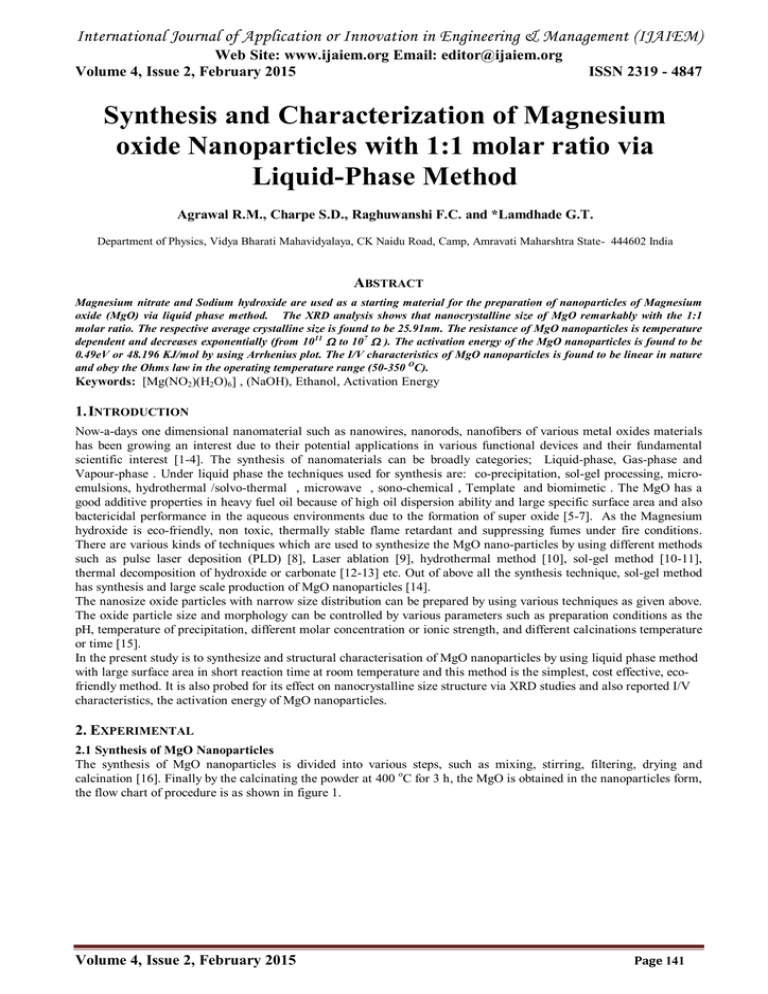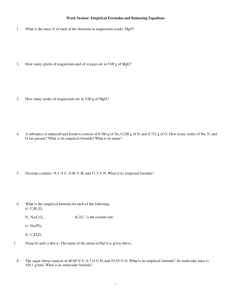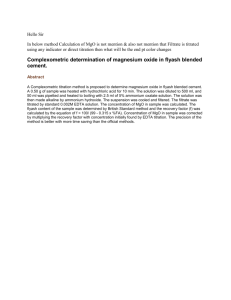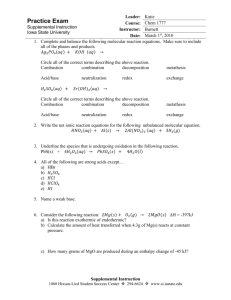International Journal of Application or Innovation in Engineering & Management... Web Site: www.ijaiem.org Email: Volume 4, Issue 2, February 2015
advertisement

International Journal of Application or Innovation in Engineering & Management (IJAIEM) Web Site: www.ijaiem.org Email: editor@ijaiem.org Volume 4, Issue 2, February 2015 ISSN 2319 - 4847 Synthesis and Characterization of Magnesium oxide Nanoparticles with 1:1 molar ratio via Liquid-Phase Method Agrawal R.M., Charpe S.D., Raghuwanshi F.C. and *Lamdhade G.T. Department of Physics, Vidya Bharati Mahavidyalaya, CK Naidu Road, Camp, Amravati Maharshtra State- 444602 India ABSTRACT Magnesium nitrate and Sodium hydroxide are used as a starting material for the preparation of nanoparticles of Magnesium oxide (MgO) via liquid phase method. The XRD analysis shows that nanocrystalline size of MgO remarkably with the 1:1 molar ratio. The respective average crystalline size is found to be 25.91nm. The resistance of MgO nanoparticles is temperature dependent and decreases exponentially (from 1011 to 107 ). The activation energy of the MgO nanoparticles is found to be 0.49eV or 48.196 KJ/mol by using Arrhenius plot. The I/V characteristics of MgO nanoparticles is found to be linear in nature and obey the Ohms law in the operating temperature range (50-350 OC). Keywords: [Mg(NO2)(H2O)6] , (NaOH), Ethanol, Activation Energy 1. INTRODUCTION Now-a-days one dimensional nanomaterial such as nanowires, nanorods, nanofibers of various metal oxides materials has been growing an interest due to their potential applications in various functional devices and their fundamental scientific interest [1-4]. The synthesis of nanomaterials can be broadly categories; Liquid-phase, Gas-phase and Vapour-phase . Under liquid phase the techniques used for synthesis are: co-precipitation, sol-gel processing, microemulsions, hydrothermal /solvo-thermal , microwave , sono-chemical , Template and biomimetic . The MgO has a good additive properties in heavy fuel oil because of high oil dispersion ability and large specific surface area and also bactericidal performance in the aqueous environments due to the formation of super oxide [5-7]. As the Magnesium hydroxide is eco-friendly, non toxic, thermally stable flame retardant and suppressing fumes under fire conditions. There are various kinds of techniques which are used to synthesize the MgO nano-particles by using different methods such as pulse laser deposition (PLD) [8], Laser ablation [9], hydrothermal method [10], sol-gel method [10-11], thermal decomposition of hydroxide or carbonate [12-13] etc. Out of above all the synthesis technique, sol-gel method has synthesis and large scale production of MgO nanoparticles [14]. The nanosize oxide particles with narrow size distribution can be prepared by using various techniques as given above. The oxide particle size and morphology can be controlled by various parameters such as preparation conditions as the pH, temperature of precipitation, different molar concentration or ionic strength, and different calcinations temperature or time [15]. In the present study is to synthesize and structural characterisation of MgO nanoparticles by using liquid phase method with large surface area in short reaction time at room temperature and this method is the simplest, cost effective, ecofriendly method. It is also probed for its effect on nanocrystalline size structure via XRD studies and also reported I/V characteristics, the activation energy of MgO nanoparticles. 2. EXPERIMENTAL 2.1 Synthesis of MgO Nanoparticles The synthesis of MgO nanoparticles is divided into various steps, such as mixing, stirring, filtering, drying and calcination [16]. Finally by the calcinating the powder at 400 oC for 3 h, the MgO is obtained in the nanoparticles form, the flow chart of procedure is as shown in figure 1. Volume 4, Issue 2, February 2015 Page 141 International Journal of Application or Innovation in Engineering & Management (IJAIEM) Web Site: www.ijaiem.org Email: editor@ijaiem.org Volume 4, Issue 2, February 2015 ISSN 2319 - 4847 Figure 1. Flow Chart of Preparation Magnesium Nitrate Hexahydrade [Mg(NO2)(H2O)6] and Sodium Hydroxide (NaOH) powder of AR grade of high purity (LOBA Chemicals) used in this work. The distilled water and Ethanol (AR grade 99.9% purity) used as a solvent and washing reagent in the chemical reaction respectively. Initially the Magnesium Nitrate Hexahydrade of wt. 5.21 gm (0.2 M) and dissolved in 200ml of distilled water. The 0.8 gm (0.2 M) of NaOH in 200ml distilled water. Then 200ml of NaOH solution is added in solution of [Mg(NO2)(H2O)6] drop-wise by using glass rod. After that, solution kept under magnetic stirring for 2 h after stirring the solution was kept on table at rest for 2 h so that, the precipitation is formed at the bottom of beaker. This precipitation was filtered and washed several times by using distilled water and Ethanol so as to get the final products. The final product is kept in vacuum oven (Quality Make, India) at 80 °C for 4 h for drying product and removing the moisture. This dried powder is then crush and make it very fine powder by using mortal pestle. Finally the fine powder of MgO is calcinated at 400 oC for 3 h for the removal of impurities present in the powder. So that we will get synthesized MgO possessed high crystallinity with the particle size in nanosized range. 3. RESULTS AND DISCUSSION 3.1 Characterization of MgO materials Figure 2. XRD of Magnesium Oxide Figure 2. shows the XRD of the MgO calcinated at 400 oC, it is clearly observed that the highest intensity peak is obtained at (200) crystal planes of MgO with FCC phase (lattice constant a of cubic unit cell: 0.421 nm), owing to diffraction peaks assigned to (111), (200) and (220) crystal planes (JCPDS Card No. 87-0653) [17]. The sharp Volume 4, Issue 2, February 2015 Page 142 International Journal of Application or Innovation in Engineering & Management (IJAIEM) Web Site: www.ijaiem.org Email: editor@ijaiem.org Volume 4, Issue 2, February 2015 ISSN 2319 - 4847 diffraction peaks were clearly seen and they are perfectly matches with crystal structure of MgO, therefore, we get clear crystallinity of MgO particles having average crystalline size in nano order. The estimated crystallite size of the synthesized MgO from the line broadening of (200) diffraction peak, which is the most preferentially oriented crystal plane, using Debye Scherrer equation [18] is approximately 25.91 nm. The Debye-Scherrer equation is as under eq. 3.1, (3.1) Where, D – is the average crystalline size, 0.94 – is the particle shape factor which was depend on the shape and size of the particle, λ- is the CuKα radiation (1.54A˚), β–is full width at half maximum (FWHM) of the selected diffraction peaks (β=0.545), θ– is the Braggs angle obtained from 2θ values which was corresponding to the maximum intensity peak in XRD pattern. (θ =0.7501rad) 3.2 Temperature Dependence of MgO Nanoparticles We have recorded the change in resistance of MgO nanoparticles by using Keithley picoammeter (Model No. 6487, Keithley Instruments Inc. USA) with increasing temperature from 50 oC to 350 oC by using digital temperature controlled furnace (Tempo Make, Mumbai). Figure 3. The variation of the resistance of MgO nanoparticles with temperature. Figure 3 shows the variation of the resistance of MgO nanoparticles with temperature, it is seen that the resistance of MgO nanoparticles varies exponentially decrease (from 1011 to 107 ) with increase in the temperature of sample. i.e. the resistance of MgO nanoparticles is temperature dependent. We have calculated dc conductivity of MgO nanoparticles by using formula given by equation 3.2.1 (3.2.1) dc = (1/ s) × ( / ) Where, Rs is sample resistance, is the thickness and is the area of the sample The Arrhenius equation gives the relation between dc conductivity and absolute temperature (reciprocal) (1/T) is given by equation 3.2.2 − / (3.2.2) dc ( ) = Where, is a pre exponential factor, temperature (K). is the activation energy, is the Boltzmann constant, and is the Figure 4. Arrhenius plot Volume 4, Issue 2, February 2015 Page 143 International Journal of Application or Innovation in Engineering & Management (IJAIEM) Web Site: www.ijaiem.org Email: editor@ijaiem.org Volume 4, Issue 2, February 2015 ISSN 2319 - 4847 Figure 4 represents Arrhenius plot between logarithmic of DC conductivity ln( dc) and 1000/ . The Arrhenius behavior (linear relations) is exist between ln( dc) and 1000/ for MgO nanoparticles, which indicate the temperature dependence of dc conductivity satisfies the Arrhenius relation. The activation energy of the MgO nano particles, calculated from ln( dc) - 1000/T plot, is found to be 0.49eV [19] or 48.196 KJ/mol [20]. The value of activation energy is less than 1eV, so that our sample shows the predominance of electronic conductivity. Figure 5. I/V Characteristics of MgO at various constant temperatures I/V characteristics of MgO nanoparticles recorded by using Keithley voltage source (Model No. 2400, Keithley Instruments Inc. USA) in the (+10 to 0 V ) and (0 to -10 V) voltage interval in the temperature range 50oC to 350oC. Fig.5 represents the I/V characteristics of MgO nanoparticles found to be linear in nature and obey Ohms law in the entire operating temperature range and I/V characteristics is also temperature dependents [19]. 4. CONCLUSIONS The major conclusions of this work can be summarized as follows; i) We are succeed to synthesize Nano-crystalline size MgO via liquid phase method i.e. sol-gel technique so as this technique is simple, fast and effective. ii) The activation energy is found to be equal obtained from literature survey. iii) The current-voltage characteristic is found to be linear and temperature dependence. REFERENCES [1] [2] [3] [4] [5] [6] [7] G.Yu, A.Cao, C.M.Liber. Nat. Nanotech. (2).pp 372,2007. B.Tian, X.Zheng, T.J.Kempa, Y.fang, N.Yu, G.Yu. J.Huang, C.M.liber., Nature (449), pp.885,2007. W.Lu,C.M.Liber, Nat.Mater.(6),pp.841,2007. M. Fernández-García, A. Rodriguez.. Metal Oxide Nanoparticles, Encyclopedia of Inorganic Chemistry, 2009. Y. R. Li, Z. Liang, Y. Zhang, J. Zhu, S. W. Jiang, and X. H. Wei, Thin Solid Films, (489), pp. 245,2005. J. Davies, J. W. Laxton, and M. J. Owers, J. Inst. Energy, (14), pp. 21,1981. J. Sawai, H. Kojima, H. Igarashi, A. Hashimoto, S. Shoji, T. Sawaki, A. Hakoda, E. Kawada, V. Kokugan,M Shimizu, World J. Microb. Biotechnol. (16), pp.187-194, 2000. [8] W. Rizwan, S. Absari, M. Dar, Y . Kim, H .Shin, Mater sci. forum (558-559),pp. 983-986, 2007. [9] P .Tran, H. Bret., M. Donald, Y. Soong , C. Minking, Opt. Laser. Eng. (46),pp. 829-834, 2008. [10] J. Wang, O. Novaro, X. Bokhimi, T. Lopez, R. Gomez, J. Navarrete, M. Llanos , E. Lopez-Salinas, Mater. Lett. (35), pp. 317-323, 1998. [11] S. Utamapanya, K. Klabunde, J. Schlup, Chem. Mater. (3), pp. 175-180, 1991. [12] D. Lide, CRC Handbook of Chemistry and Physics, CRC Press, Boca Raton - New York, 2004. [13] M. Aramendia, V. Borau , C. Jimenez, J. Mater. Chem. 6(12), pp. 1943-1949, 1996. [14] T. Lopez, R. Gomez, Journal of Solid State Chemistry (115), pp. 411–415, 1995. [15] M. Laska, J. Valtyni, P. Fellner, Cryst. Res. Tech., (28), pp. 931, 1993. [16] G. Moussavi, M. Mahmoudi, Journal of Hazardous Materials (168), pp. 806–812, 2009. Volume 4, Issue 2, February 2015 Page 144 International Journal of Application or Innovation in Engineering & Management (IJAIEM) Web Site: www.ijaiem.org Email: editor@ijaiem.org Volume 4, Issue 2, February 2015 [17] [18] [19] [20] ISSN 2319 - 4847 V. Smith, X-ray Powder Data File, American Society for Testing Materials, 1960. B. Cullity, Elements of X-ray Diffraction. Massachusetts, Addison-Wesley Publication Company, 1978. N. Kilincl, L. Arda, S. Ozturk, Z. Ozturk, Cryst. Res. Technol. 45, (5), pp. 529 – 538, 2010. T. Jeffrey, M. Simone, P. Ivan, J. Am. Ceram. Soc., 97 (1), pp. 275– 282,2014. Volume 4, Issue 2, February 2015 Page 145






